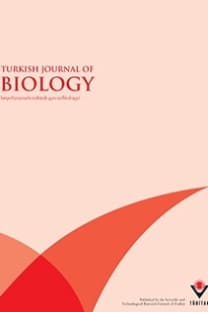Purification and characterization of endoxylanase Xln-2 from Aspergillus niger B03
Key words: Endoxylanase, purification, characterization, Aspergillus niger, xylan
Purification and characterization of endoxylanase Xln-2 from Aspergillus niger B03
Key words: Endoxylanase, purification, characterization, Aspergillus niger, xylan,
___
- Sandrim VC, Rizzatti AC, Terenzi HF et al. Purifi cation and biochemical characterization of two xylanases produced by Aspergillus caespitosus and their potential for kraft pulp bleaching. Process Biochem 40: 1823-1828, 2005.
- Kolenová K, Vršanská M, Biely P. Purifi cation and characterization of two minor endo-β-1,4-xylanases of Schizophyllum commune. Enzyme Microbial Technol 36: 903- 910, 2005.
- Fawzi EM. Highly thermostable purifi ed xylanase from Rhizomucor miehei NRRL 3169. Ann Microbiol 60: 363-368, 2010.
- Beg QK, Kapoor K, Mahajan L et al. Microbial xylanases and their industrial applications: a review. Appl Microbiol Biotechnol 56: 326-338, 2001. 5. Collins T, Gerday C, Feller G. Xylanases, xylanase families and extremophilic xylanases. FEMS Microbiol Rev 29: 3-23, 2005.
- Li XL, Ljungdahl LG. Cloning, sequencing, and regulation of a xylanase gene from the fungus Aureobasidium pullulans Y-2311-1. Appl Environ Microbiol 60: 3160-3169, 1994.
- Th omson JA. Molecular biology of xylan degradation. FEMS Microbiol Rev 104: 65-82, 1993. 8. Biely P, Vrsanská M, Tenkanen M et al. Endo-β-1,4-xylanase families: diff erences in catalytic properties. J Biotechnol 57: 151-166, 1997.
- Dobrev G, Zhekova B, Delcheva G et al. Purifi cation and characterization of endoxylanase Xln-1 from Aspergillus niger B03. World J Microbiol Biotechnol 25: 2095-2102, 2009.
- Laemmli UK. Cleavage of structural proteins during the assembly of the head of bacteriophage T4. Nature 227: 680- 685, 1970.
- Miller GL. Use of dinitrosalicylic acid reagent for determination of reducing sugar. Anal Chem 31: 426-428, 1959.
- Ronen R, Zauberman G, Akerman M et al. Xylanase and xylosidase activities in avocado fruit. Plant Physiol 95: 961- 964, 1991.
- Ponpium P, Ratanakhanokchai K, Kyu K. Isolation and properties of a cellulosome-type multienzyme complex of the thermophilic Bacteroides sp. strain P-1. Enzyme Microbial Technol 26: 459-465, 2000.
- Delcheva G, Pishtiyski I, Dobrev G et al. Immobilization of Aspergillus niger pectinase on polyacrylonitrile copolymer membrane. Trends Appl Sci Res 2: 419-425, 2007.
- Bailey MJ, Biely P, Poutanen K. Interlaboratory testing of method for assay of xylanase activity. J Biotechnol 23: 257-270, 1992.
- Dubois M, Gilles KA, Hamilton JK et al. Colorimetric method for determination of sugars and related substances. Anal Chem 28: 350-356, 1956.
- Lowry OH, Rosebrough NJ, Farr AL et al. Protein measurement with the Folin phenol reagent. J Biol Chem 193: 265-275, 1951.
- Lemos JLS, Bon EPS, Santana MFE et al. Th ermal stability of xylanases produced by Aspergillus awamori. Braz J Microbiol 31: 206-211, 2000.
- Lv Z, Yang J, Yuan H. Production, purifi cation and characterization of an alkaliphilic endo-β-1,4-xylanase from a microbial community EMSD5. Enzyme Microbial Technol 43: 343-348, 2008.
- Maalej I, Belhaj I, Masmoudi NF et al. Highly thermostable xylanase of the thermophilic fungus Talaromyces thermophilus: purifi cation and characterization. Appl Biochem Biotechnol 158: 200-212, 2009.
- Martínez-Trujillo A, Pérez-Avalos O, Ponce-Noyola T. Enzymatic properties of a purifi ed xylanase from mutant PN- 120 of Cellulomonas fl avigena. Enzyme Microbial Technol 32: 401-406, 2003.
- ISSN: 1300-0152
- Yayın Aralığı: 6
- Yayıncı: TÜBİTAK
Antimicrobial and antioxidant properties of Artemisia L. species from western Anatolia
Şüra BAYKAN EREL, Gottfried REZNICEK, Serdar Gökhan ŞENOL
Protective effects of β-carotene and silymarin on human lymphocytes
Erkan YURTCU, Ezgi KASAPOĞLU, Feride İffet ŞAHİN
Muhammet TONGUÇ, Ruziye ELKOYUNU, Sabri ERBAŞ, Yaşar KARAKURT
Anti-inflammatory effects of different extracts from three Salvia species
Elif ÇADIRCI, Halis SÜLEYMAN, Perihan GÜRBÜZ, Ayşe KURUÜZÜM UZ, Zühal GÜVENALP, Lütfiye Ömür DEMİREZER
Olawale Olufemi ADELOWO, Obasola Ezekiel FAGADE
Özgür KEBABCI, Nilüfer CİHANGİR
Salvia türünün farklı ekstrelerinin antienfl amatuvar etkileri
Lütfiye Ömür DEMİREZER, Perihan GÜRBÜZ, Elif ÇADIRCI, Zühal GÜVENALP, Halis SÜLEYMAN, KURUÜZÜM Ayşe UZ
Padmavathi TALLAPRAGADA, Usha SESHACHALA
Elif İpek SATAR, Ersin UYSAL, Erhan ÜNLÜ, Mehmet BAŞHAN, Ali SATAR
Hassen TEYEB, Nahla ZANINA, Mohamed NEFFATI, Wahiba DOUKI, Mohamed Fadhel NAJJAR
